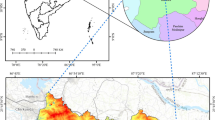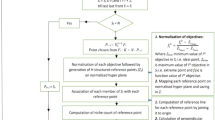Abstract
Context
The concept of ecosystem services (ES) has become mainstreamed in environmental planning and management recently, and with that various tools for quantifying ecosystem services have emerged. However, designing the tools for integrated assessment and optimization of multiple ES has become a challenging task.
Objectives
In order to promote the efficiency of ecosystem planning and management, we develop a spatial decision support tool named SAORES, which provides a platform for exploratory scenario analysis and optimal planning design, rather than ES assessment.
Method
SAORES is formed with four modules: the scenario development module, the integrated ecosystem service model base, the ecosystem service trade-off analysis module, and the multi-objective spatial optimization module based on NSGA-II. Using SAORES, we make a case study on the Yangou catchment of the Loess Plateau, China. Based on impact assessment of the Grain to green program (GTGP), we optimize the farmland retiring planning, involving multiple objectives which include the eco-compensation and the key ES.
Results
The integrated assessment shows that, the aim of the GTGP, the water and soil retention are prominent improved. Optimization for GTGP provides a series of optimal solutions, which are better than other single optimized solutions, and are twice the cost-effectiveness of the actual situation.
Conclusions
SAORES, as a decision support tool, can improve the scenario analysis and multi-objective optimal planning design for ecosystem management and planning. The case study demonstrates the potential and effectiveness of SAORES and spatial multi-objective optimization model for ecosystem service management, especially in the Loess Plateau.









Similar content being viewed by others
References
Bagstad KJ, Villa F, Johnson G, Voigt B (2011) ARIES—artificial intelligence for ecosystem services: a guide to models and data, version 1.0 beta. The ARIES Consortium, Bilbao
Bagstad KJ, Semmens DJ, Waage S, Winthrop R (2013) A comparative assessment of decision-support tools for ecosystem services quantification and valuation. Ecosyst Serv 5:27–39
Boumans R, Costanza R (2007). The multiscale integrated Earth Systems model (MIMES): the dynamics, modeling and valuation of ecosystem services. Global assessments: Bridging scales and linking to policy. Report on the joint TIAS-GWSP workshop held at the University of Maryland University College Adelphi, USA, 10 and 11 May, GWSP issues in Global Water System Research, no. 2 (Vol. 2), (pp: 102–106). Bonn: GWSP IPO
Budyko MI (1974) Climate and life. Academic Press, San Diego
Cao K, Batty M, Huang B, Liu Y, Yu L, Chen J (2011) Spatial multi-objective land use optimization: extensions to the non-dominated sorting genetic algorithm-II. Int J Geogr Inf Sci 25(12):1949–1969
Costanza R, d’Arge R, De Groot RS, Farber S, Grasso M, Hannon B (1997) The value of the world’s ecosystem services and natural capital. Nature 387(15):253–260
Daily GC (1997) Nature’s services: societal dependence on natural ecosystems. Island Press, Washington, pp 1–49
Daily GC, Polasky S, Goldstein J, Kareiva PM, Mooney HA, Pejchar L, Ricketts TH, Salzman J, Shallenberger R (2009) Ecosystem services in decision making: time to deliver. Front Ecol Environ 7(1):21–28
Daily GC, Kareiva PM, Polasky S, Ricketts TH, Tallis H (2010) Mainstreaming natural capital into decisions. Oxford University Press, Oxford, pp 3–14
Datta D, Deb K, Fonseca CM, Lobo FG, Condado PA, Seixas J (2007) Multi-objective evolutionary algorithm for land use management problem. Int J Comput Intell Res 3(4):371–384
De Groot RS, Alkemade R, Braat L, Hein L, Willemen L (2010) Challenges in integrating the concept of ecosystem services and values in landscape planning, management and decision making. Ecol Complex 7(3):260–272
Deb K (2001) Multi-objective optimization using evolutionary algorithms. Wiley, Chichester
Ducheyne EI, De Wulf RR, De Baets B (2006) A spatial approach to forest-management optimization: linking GIS and multiple objective genetic algorithms. Int J Geogr Inf Sci 20(8):917–928
Feng M, Liu S, Euliss NH Jr, Young C, Mushet DM (2011) Prototy** an online wetland ecosystem services model using open model sharing standards. Environ Model Softw 26(4):458–468
Fotakis D, Sidiropoulos E, Myronidis D, Ioannou K (2012) Spatial genetic algorithm for multi-objective forest planning. For Policy Econ 2012(21):12–19
Fu BJ, Liu Y, Lu YH, He CS, Zeng Y, Wu BF (2011). Assessing the soil erosion control service of ecosystems change in the Loess Plateau of China. Ecol Complex 8(4):284–293
Groot JCJ, Rossing WAH (2011) Model-aided learning for adaptive management of natural resources—an evolutionary design perspective. Methods Ecol Evol 2:643–650
Guzy MR, Smith CL, Bolte JP, Hulse DW, Gregory SV (2008) Policy research using agent based modeling to assess future impacts of urban expansion into farmlands and forests. Ecol Soc 13(1):37
Jackson B, Pagella T, Sinclair F, Orellana B, Henshaw A, Reynolds B, McIntyre N, Wheater H, Eycott A (2013) Polyscape: a GIS map** toolbox providing efficient and spatially explicit landscape-scale valuation of multiple ecosystem services. Landsc Urban Plan 112:74–88
Jankowski P, Fraleya G, Pebesma E (2014) An exploratory approach to spatial decision support. Comput Environ Urban Syst 45:101–113
Johnston K, Ver Hoef JM, Krivoruchko K, Lucas N (2001) Using ArcGIS geostatistical analyst. ESRI Press, Redlands
Lester SE, Costello C, Halpern BS et al (2013) Evaluating tradeoffs among ecosystem services to inform marine spatial planning. Mar Policy 38:80–89
Lieth H, Box E (1972) Evapotranspiration and primary productivity. Thornthwaite memorial model. Publ Climatol 25(2):37–46
Liu S, Costanza R, Farber S, Troy A (2010) Valuing ecosystem services. Ann N Y Acad Sci 1185(1):54–78
Lü YH, Fu BJ, Feng XM, Zeng Y, Liu Y, Chang R, Sun G, Bingfang B (2012) A policy-driven large scale ecological restoration: quantifying ecosystem services changes in the Loess Plateau of China. PLoS One 7(2):e31782. doi:10.1371/journal.pone.0031782
MA (Millennium Ecosystem Assessment) (2005) Current state and trends: synthesis. Island Press, Washington, pp 829–838
NatureServ (2013) NatureServe Vista: decision support for better planning. Available from: http://www.natureserve.org/conservation-tools/natureserve-vista. Accessed 12 Nov 2014
Osyczka A (1985) Computer aided multi-criterion optimization method. Adv Model Simul. AMSE Press 3(4):41–52
Parametrix (2010) An introduction to EcoMetrix: measuring change in ecosystem performance at the site scale. Parametrix, Portland
Pareto V (1896) Cours D’Economie Politique. Rouge, Lausanne
Polasky S, Nelson E, Camm J, Csuti B, Fackler P, Lonsdorf E, Montgomery C, White D, Arthur J, Garber-Yonts B, Haight R, Kagan J, Starfield A, Tobalske C (2008) Where to put things? Spatial land management to sustain biodiversity and economic returns. Biol Conserv 2008(141):1505–1524
Raudsepp-Hearne C, Peterseon GD, Bennett EM (2010) Ecosystem service bundles for analyzing tradeoffs in diverse landscapes. Proc Natl Acad Sci USA 107:5242–5247
Roberts SA, Hall GB, Calamai PH (2011) Evolutionary multi-objective optimization for landscape system design. J Geogr Syst 13:299–326
Seppelt R, Lautenbach S, Volk M (2013) Identifying trade-offs between ecosystem services, land use, and biodiversity: a plea for combining scenario analysis and optimization on different spatial scales. Curr Opin Environ Sustain 5(5):458–463
Stewart TJ, Janssen R, van Herwijnen M (2004). A genetic algorithm approach to multiobjective land use planning. Computers and Operations Research 31(14):2293–2313
Tallis HT, Ricketts T, Guerry A, Wood SA, Sharp R, Nelson E, Ennaanay D, Wolny S, Olwero N, Vigerstol K, Pennington D, Mendoza G, Aukema J, Foster J, Forrest J, Cameron D, Arkema K, Lonsdorf E, Kennedy C, Verutes G, Kim CK, Guannel G, Papenfus M, Toft J, Marsik M, Bernhardt J, Griffin R (2013) InVEST2.5.3 User’s Guide. The Natural Capital Project, Stanford
The Ministry of Land and Resources, PRC (2003) The regulations of farmland grading (TDPT 1004–2003). Standards Press of China, Bei**g
Verburg PH, Soepboer W, Veldkamp A, Limpiada R, Espaldon V, Mastura SS (2002) Modeling the spatial dynamics of regional land use: the CLUE-S model. Environ Manage 30(3):391–405
Volk M (2013) Sustainability of water quality and ecology. Ecol Process 1(2):3–9
Waage S, Armstrong K, Hwang L (2011) New business decision-making aids in an era of complexity, scrutiny, and uncertainty: tools for identifying, assessing, and valuing ecosystem services. BSR, San Francisco
Wainger LA, King DM, Mack RN, Price EW, Maslin T (2011) Can the concept of ecosystem services be practically applied to improve natural resource management decisions? Ecol Econ 69(5):978–987
World Resources Institute (WRI) (2012) The corporate ecosystem services review: guidelines for identifying business risks and opportunities arising from ecosystem change, version 2.0. World Resources Institute, Washington
Zheng ZM, Fu BJ, Hu HT, Sun G (2014) A method to identify the variable ecosystem services relationship across time: a case study on Yanhe Basin, China. Landscape Ecol 29:1689–1696
Acknowledgments
This work was funded by the National Natural Sciences Foundation of China (No. 41230745) and the CAS/SAFEA International Partnership Program for Creative Research Teams of “Ecosystem Processes and Services”.
Author information
Authors and Affiliations
Corresponding author
Rights and permissions
About this article
Cite this article
Hu, H., Fu, B., Lü, Y. et al. SAORES: a spatially explicit assessment and optimization tool for regional ecosystem services. Landscape Ecol 30, 547–560 (2015). https://doi.org/10.1007/s10980-014-0126-8
Received:
Accepted:
Published:
Issue Date:
DOI: https://doi.org/10.1007/s10980-014-0126-8




